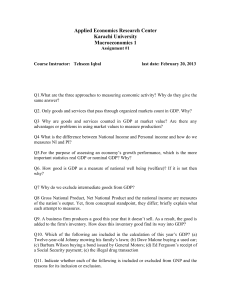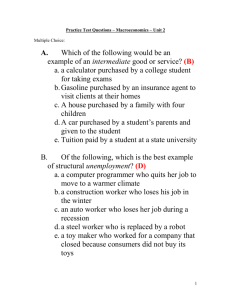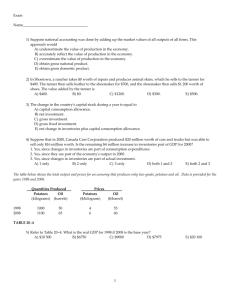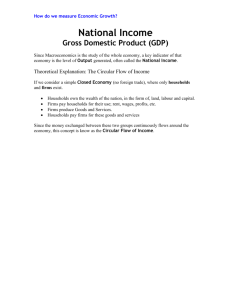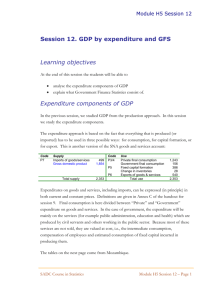THE REVISED PHILIPPINE SYSTEM OF NATIONAL ACCOUNTS
advertisement
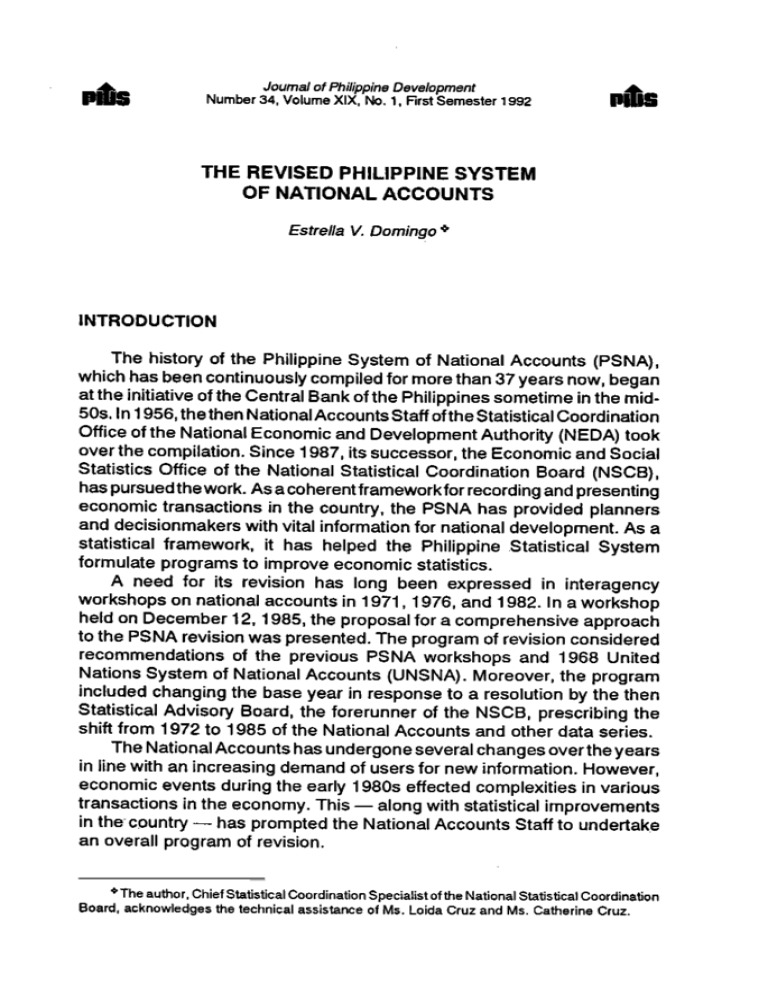
i_ Number34, VolumeXIX, No. 1, FirstSemester1992 Journal of Philippine Development I_ THE REVISED PHILIPPINE SYSTEM OF NATIONAL ACCOUNTS Estrella V. Domingo _ INTRODUCTION The historyof the PhilippineSystem of National Accounts (PSNA), whichhasbeen continuouslycompiledformorethan37 yearsnow, began at the initiativeof theCentralBank ofthe Philippinessometimein themid50s, In 1956,thethenNationalAccountsStaffoftheStatisticalCoordination Officeof the NationalEconomicand DevelopmentAuthority(NEDA) took overthe compilation.Since 1987, its successor,the Economicand Social StatisticsOffice of the National StatisticalCoordinationBoard (NSCB), haspursuedthework.Asa coherentframeworkfor recordingandpresenting economictransactionsin the country,the PSNA has providedplanners and decisionmakerswithvital informationfor nationaldevelopment.As a statisticalframework, it has helped the PhilippineStatistical System formulateprogramsto improveeconomicstatistics. A need for its revision has long been expressed in interagency workshopson nationalaccountsin 1971, 1976, and 1982. In a workshop held on December 12, 1985, the proposalfor a comprehensiveapproach to the PSNA revisionwas presented.The programof revisionconsidered recommendationsof the previous PSNA workshops and 1968 United Nations System of National Accounts(UNSNA). Moreover, the program includedchangingthe base year in responseto a resolutionby the then StatisticalAdvisory Board, the forerunnerof the NSCB, prescribingthe shiftfrom 1972 to 1985 of the NationalAccountsand otherdata series. The NationalAccountshasundergoneseveralchangesovertheyears in linewithan increasingdemandof usersfor new information.However, economicevents duringthe early 1980s effected complexitiesin various transactionsin the economy.This-- alongwith statisticalimprovements in thecountry -- has promptedthe NationalAccountsStaffto undertake an overallprogramof revision. Theauthor,ChiefStatisticalCoordination SpecialistoftheNationalStatisticalCoordination Board,acknowledgesthe technicalassistanceof Ms. LoidaCruzand Ms.CatherineCruz. 60 JOURNAL OF PHILIPPINE DEVELOPMENT Economic Changes and Developments In late 1970sthe government's participationinthe economyexpanded. For one, the number of government-owned and -controlled corporations rose from 74 in 1973 to 245 in 1985. In addition, the government assumed a new role in the financial market of guaranteeing private sector loans granted by the government financial institutions (GFI). When recession followed the second oil shock in 1979 and several corporations underwent deep financial distress, the government took over them. Furthermore, the government bailed out GFI's saddled at that time with nonperforming assets brought about by guaranteed loans extended to private and government corporations. These economic events gave rise to complex transactions unique to the Philippines. Since the UNSNA dealt with concepts, interpreting correctly and translating these transactions into national accounts entries--particularly the assumption of non-performing assets and liabilities of government corporationsby the national government -- resulted in conceptual and methodological problems for the PSNA, Moreover, pertinent to estimation of Gross National Product are issues on extent of the public debt and contribution of the informal sector. Hence, these problems calledfor a review of concepts and existing methodologies to assess the capability and responsiveness of accounts in capturing and properly recording these transactions. Likewise, these pointed out the need for more articulation in the accounts. Statistical Developments Compilationof nationalaccountsinvolvesadynamicprocess. Improving the sourcesof datato meetrequirementsof nationalaccountscompilation and the methodsof estimationto yieldbetter and more usefulinformation is a never-ending exercise. Developmentsin the statisticalsphere resulted in availabilityof new sourcesofdataotherthanthetraditionalsurveysand censusesconducted by the National Statistics Office (NSO). Data from administrative byproductsof regulatoryor supervisorygovernmentagencies have been usedto supplementadditionaldata requirementsto comeup witha more articulatedaccounts.In addition,resultsof pastsurveysand censuses-unavailableat thetime theannual estimateswere beingcompiled-- have nowbecomeavailable;hence,the needto revisethepastestimatesmostly based on trends and unupdatedratiosand indicators. DOMINGO: PHILIPPINE SYSTEM OF NATIONAL ACCOUNTS 61 GENERAL FEATURES OF THE NEW SERIES Revision of the PSNA is focused on the annual compilation of the accounts, initially covering the period 1980 to 1987. The new series is characterized by the expansion in sectoral coverage and the changes in data and estimation methods in the items of certain accounts. With available updated or new data series, the staff expanded the coverage and improved the estimation methods. Coverage expanded invarying degrees, in agriculture, construction, mining, electricity, gas, and water, government services, government consumption expenditures, fixed capital formation, increase in stocks, and foreign trade. Another feature of the revised PSNA series is the adoption of the recommendation ofthe 1968 UNSNA and to some extent of the preliminary recommendations of the 1993 USNA. The old PSNA series was basically patterned after the 1953 USNA. Though the 1968 UNSNA was more comprehensive than the 1953 version, the Economic and Social Statistics Office of the NSCB took a long time to shift to this framework because the data system could hardly support the data demands for compiling the accounts based on this revised framework. The United Nations is currently revising its SNA. Some of the problems encountered in implementing the 1968 recommendation are reviewed and to some extent resolved. The new PSNA series incorporated some recommendations in the 1993 UNSNA. With the adoption of the revised 1968 UNSNA framework and the ava'ilability of new information, the new series now features further articulation of transaction flows through additional accounts. In the past, there were no complete and integrated accounts, Now, there is the Consolidated Account_ of the Nation, which includes the Gross Domestic Product and Expenditure, National Disposable Income, Gross Accumulation, and External Transactions Accounts (See Charts 1-4). The new series has incorporated the Institutional Production and Income and Outlay Accounts forPrivate Corporations, Public Corporations, General Government and Household and Unincorporated Enterprises (See Charts 5-8). However, the revision has been unable to undertake the estimation of a capital finance account as recommended by the UNSNA pending the development of the data base for this account. Moreover, the new series now estimates GDP by factor shares, compensation of employees, depreciation, operating surplus and indirect taxes net of subsidies, for better articulation between the production account and income and outlay account. Estimates by factor shares are shown both as originating from the economic or institutional sectors. 62 JOURNALOF PHILIPPINEDEVELOPME_IT Chart 1 CONSOLIDATED ACCOUNTS I: GROSS DOMESTIC PRODUCT AND EXPENDITURE Transaction Items 1. 2. 3. 4. 5. Compensation of employees Net operating surplus A. Interest payment B. Profit Depreciation Indirecttaxes Less : Subsidies GROSS DOMESTIC PRODUCT 6. 7. 8. 9. 10. 11. Personal consumptionexpenditure General governmentconsumptionexpenditure Gross domesticcapital formation A. Fixed capital B. Changes in stocks Exportsof goods and services Less: importsof goods and services Statistical discrepancy EXPENDITURE ON GROSS DOMESTIC PRODUCT A fifth feature of the PSNA revision is the quantification of the contribution of the unorganized and organized sectors to production. The unorganized sector refers to that part of the economy unreported or undocumented in the establishment surveys. Table 2 shows the GDP structure, consisting of the unorganized and organized sectors for CY 1985-87. COMPARISON OF THE NEW AND OLD PSNA Change in Levels Comparing the new with the old series estimates of Gross Domestic Product (GDP) reflects an apparent decrease in the new series levels on the average by P28.2 billion annually at current prices and P30.3 billion annually at constant prices (Table 1). The new series estimates of Gross National Product (GNP) are likewise lower than the old series on the average by P30.3 billion annually at current prices and P31.8 billion annually at constant prices. DOMINGO: PHILIPPINE SYSTEM OF NATIONALACCOUNTS NATIONAL Chart 2 CONSOLIDATED ACCOUNTS I1: DISPOSABLE INCOME AND ITS APPROPRIATION Transaction Items 1. 2. 3, Personal consumptionexpenditure General government consumption expenditure Net saving APPROPRIATION OF NET NATIONAL DISPOSABLE INCOME 4. Compensation of employees A. From resident producers B, From rest of the world C, Less : to the rest of the world Net operating surplus A, From resident producers B. From rest of the world C. Less : to the rest of the world Indirect 1axes Less: Subsidies Current transfers from the rest of the world Less: Current transfers to the rest of the world 5, 6. 7. 8, 9, 63 NET NATIONAL DISPOSABLE INCOME 10, Memorandum items: A, Net national income (Net National Product) at factor cost (4+5) B, Net national income (Net National Product) at market prices (10A+6 -7) Chart 3 CONSOLIDATED ACCOUNTS GROSS ACCUMULATION Transaction IIh items 1. 2, 3. Gross fixed capital formation Changes in stocks Net lending to the rest of the world GROSS ACCUMULATION 4. Institutional saving, net A. Private corporations B. Government corporations C, General government D. Households and unincorporated enterprises Depreciation Capital transfer from the rest of the world Less: Statistical discrepancy 5, 6. 7. FINANCE OF GROSS ACCUMULATION 64 JOURNAL OF PHILIPPINE DEVELOPMENT Chart 4 CONSOLIDATED ACCOUNTS IV: EXTERNAL TRANSACTIONS Transaction 1. 2. 3. 4_ Exports of goods and services A. Merchandise FOB, SNA* Merchandise FOB, FTS *'* Less: Special transactions Plus: Monetization of gold B, Non-factor services Compensation of employees from the rest of the world Property and entrepreneurial income from the rest of the world Current transfers from the rest of the world A. To general government B. To households CURRENT 5. 6. 7. 8. 9. 10. RECEIPTS Imports of goods and services A. Merchandise CIF, SNA* Merchandise FOB, FTS** Plus :Insurance and freight, FTS Less : Special transactions Plus : Demonetization of gold, CBP*'** B. Non-factor services Compensation of employees to the rest of the world Property and entrepreneurial income to the rest of the world Government interest payments on public debt Current transfers to the rest of the world A, Government contributions to international organizations B. Households Surplus on current transactions "CURRENT 11. 12, 13. Items DISBURSEMENTS Surplus on current transactions Capital transfers from the rest of the world Net lending to the rest of the world * SNA -- SystemofNationalAccounts, ** ForeignTrade Statistics(NSO) *"* Balanceof Payments,CentralBankof the Philippines(CBP). DOMINGO: PHILIPPINE SYSTEM OF NATIONAL ACCOUNTS Chart 5 INCOME AND OUTLAY ACCOUNT PRIVATE CORPORATIONS Transaction 1. 2, 3. 4, 65 h Items Net operating surplus Property income Casualty insurance claims Net casualty insurance premiums TOTAL RECEIPTS 5, 6. 7, 8. 9. 10. Interest payments Dividends Net casualty insurance premiums Casualty insurance claims Direct taxes Savings TOTAL DISBURSEMENTS Chart 6 INCOME AND OUTLAY ACCOUNT GOVERNMENT CORPORATIONS Transaction Items 1, 2. Net operating surplus Interest income and dividends 3. 4, Net casualty insurance premiums Casualty insurance claims TOTAL RECEI PTS 5, 6. Interest payments Dividends 7. 8, 9. 10, Casualty insurance claims Net casualty insurance premiums Current transfers to households Direct taxes 1 1, Saving TOTAL DISBURSEMENTS Ih 66 JOURNAL OF PHILIPPINE DEVELOPMENT Change in Growth In growth, Rates the difference between the new and the old series is insignificant. The average annual growth rates at current prices of both GDP and GNP in the new series are slightly higher by 0.28 and 0.30 percentage points, respectively, than the old series. At constant prices, the average annual growth rate of GDP is lower by 0.09 percentage points while for GNP the percent difference is 0,06 percentage points. Change In Structure Gross Domestic Product In terms of sectoral contribution to GDP, the share of the industry sector to the annual average GDP at current prices in the new series rose to 36.09 percent, or is higher by 2.31 percentage points than in the old series. On the other hand, the share of the services sector fell to 40.54 percent from 42,35 percent in the old series. agriculture, fishery and forestry 23,87 percent in the old series, sector Likewise, declined Chart 7 INCOME AND OUTLAY ACCOUNT GENERAL GOVERNMENT Transaction Items 1. 2, 3, 4. 5, Net operating surplus Property income Compulsory fees and fines Indirect taxes Direct taxes 6. 7. a, Social security contributions Casualty insurance claims Current transfers TOTAL RE-'CEIPTS 9, 10. 11. 12. 13. 14, 15. Government consumption expenditure Subsidies Social security benefits Net casualty insurance premiums Interest payment on public debt Other current transfers Saving TOTAL DISBURSEMENTS the share to 23.37 IIh percent of the from DOMINGO:PHILIPPINESYSTEMOFNATIONALACCOUNTS 67 At constant prices, the share of the agriculture sector slightly decreased to 23.38 percent while that of the industry sector went up by 3.27 percentage points to 37.53 percent in the new series. 3he share of the services sector decreased to 39,09 percent in the new series, or down by 2.06 percentage points from the old series, Gross Domestic Expenditure In the new series, Personal Consumption Expenditure (PCE) accounted for 70.0 percent of the annual average expenditure of the GDP at current prices, lower by 3.3 percentage points from the share of PCE in the old series. Meanwhile, increases in the share in the annual average expenditure were registered in General Government Consumption Expenditure (GGCE), Gross Domestic Capital Formation (GDCF), Exports and Imports as well as in Statistical Discrepancy. Chart 8 INCOME AND OUTLAY ACCOUNT IV: HOUSEHOLDS AND UNINCORPORATED ENTERPRISES Transaction Items 1. 2. 3. 4. 5. 6. 7. Net operating surplus Compensation of employees Interest on publicdebt from general government Other interest income Social security benefits Casualty insuranceclaims Current transfers TOTAL RECEIPTS 8. 9. 10. 11. 12. 13. 14. 15. 16. Personal consumptionexpenditure Interest payments on consumer debt Other interest payments Direct taxes Compulsory fees, fines and penalties Social security contribution Net casualty insurance premiums Current transfers Saving TOTAL DISBURSEMENTS 17. Memorandum item: Personal disposable income (1 to 6) - (9 to 15) or (8 + 16) 68 JOURNALOFPHILIPPINEDEVELOPMENT Table 1 .RESULTS OF THE REVISION (1980-1990) A. 1, Change in Levels Decrease in the estimate of Gross Domestic Product (GDP) Average Annual Difference (BillionP) GOP Current GOP Constant 2, Pe rcent Difference* -28.20 -30.34 -4.63 -4,53 Decrease in the estimate of Gross National Product (GNP) Average Annual Difference (Billion P) GNP Current GNP Constant B, Percent Difference* -30.29 -31.79 -5.02 -4.80 Change in Growth Rates Average Annual Growth Rates New Old Difference GDP Current GDP Constant 15,90 1,57 15,62 1,66 .28 -,09 GNP Current GNP Constant 15.95 1,62 15.65 1,68 .30 -,06 C. Changes in Structure 1, By economic activity Share in Annual Average GDP CURRENT New GDP Agriculture, fishery and forestry Industry Services Old 100,00 100,00 23.37 36.09 40.54 23.87 33,78 42.35 *Computed asnewlevelminusoldlevel,divided byoldlevel. Change *,50 2,31 -1.81 DOMINGO:PHILIPPINESYSTEMOF NATIONAL ACCOUNTS 69 Table 1 (Continued) GDP Agriculture, fishery and forestry Industry Services 2. New CONSTANT Old 100.00 t00.00 23.38 37.53 39.09 24.59 34.26 41.15 Change -1.21 3.27 -2.06 By expenditure shares Share in Annual Average GDP CURRENT New Old Change GDP Personal consumption expenditure Government consumption expenditure Gross domestic capital expenditure Exports Imports Statistical discrepancy 100,00 100,00 69,95 73.28 -3,33 8.61 8.28 0,33 21.10 25.90 -27.47 1.90 19.00 22.56 -23.76 0,65 2,10 3.34 -3.71 1.25 New GDP 100.00 Personal consumption expenditure 69.74 Government consumption expenditure 7.61 Gross capital formation 22.13 Exports 26.86 Imports -28.94 Statistical discrepancy 2.60 CONSTANT Old - Change 100.00 73.03 -3,29 7.15 0,46 20.45 21.73 -25,85 3.49 1,68 5.13 -3.09 -.89 70 JOURNAL OFPHILIPPINE DEVELOPMENT Table2 GDP STRUCTUREAT CURRENTPRICES Organized Unorganized Total 1985 % 1986 ,% 1987 % 54.90 45.10 100.00 53.60 46.20 100.00 53.70 46.30 100.00 At constantprices, the shareof PCE decreased to 69.74 percent from the 73.03 percent share in the old series. The share of GGCE, GDCF, Exports and Imports went up in the new series, with exports and imports recording high increases of 5.1 and 3.1 percentage points, respectively, from the old series. PRODUCTION ACCOUNTS The revisedproductionaccountwhichapproachesthe estimationof GDP byestimatingthe GrossValue Added (GVA) of the differentproduction sectors shows marked differencesfrom the old series. Included among them are: generally lower GVA levels at current and constant prices,changes in sectoral contributionto GDP, varyingsectoral growth trends at certain periods, particularlyfor forestry; miningand quarrying; electricity,gas and water; privateservices;finance and housing.These diffe'rencesare the combined resultof the improvementsincorporatedin each of the new GVA estimatesby sector. Agriculture, Fishery and Forestry New estimatesfor agriculture,fisheryand forestryreflect a reduced GVA bothat currentand constantprices.In termsof growthrate, the new series does not vary significantlyfrom the oldseries. The changein the GVA estimatesforthe sectorcan be tracedto the combinedeffectof certainimprovementscarriedoutin the revision.First, agriculturalactivities and services which include irrigationservices, pest control services, orchidariums, etc. were added as a subsector under agriculture. Second, the following changes in data were adopted: use of Bureau of Agricultural Statistics (BAS) revised production data on other crops, livestock and poultry, which are higher thanthe old data; application of BAS new price series for some crops, livestock and poultry which are much lower resulting in decreased currentvalue of production inspite of the upward revision in production data; and adoption of updated Gross Value DOMINGO:PHILIPPINESYSTEMOF NATIONAL ACCOUNTS 71 Added Ratios (GVAR's) based on the 1985 Input-Output table. Generally, the new GVAR's are higher than the old GVAR's. The revised estimates for forestry considered undercoverage/ underreporting in forestry production. Moreover, the new estimates of real GVA for forestry were based on current-weighted price deflators as against the constant weights used in the old series. Industry Effects of the revision on the total GVA for industry are higher GVA levels both at current and constant prices or an average annual difference of 1.87 percent and 4.58 percent, respectively. Growth trends in the two series are basically the same. On the other hand, the effects of the sectoral revision are not the same for the sectors. In mining and quarrying, the revised GVA estimates are lower prior to 1985 but higher from 1985 to 1987. In manufacturing, the revised estimates are lower than the old series, both at current and constant prices. However, for construction and electricity, gas and water, the revision resulted in higher GVA levels. The above changes reflected in the new series can be attributed to the changes incorporated in the revision for each sector of the industry. In mining, the new output included the production of panned gold, 50 percent of which is considered unaccounted for and goes to the black market. Updated annual GVAR's were applied to come up with the new GVA estimates, using submitted financial statements of mining firms to the Bureau of Mines and Geosciences (BMG). Moreover, the revised series shifted from double to single deflation method to obtain GVA at constant prices for mining. In manufacturing, the new GVA series used newly available data on output and intermediate input from the Annual Survey of Establishments (ASE) and the Census of Establishments (CE). Improvements in methodology were introduced as follows: the use of the commodity flow approach in estimating output for six subsectors in food manufacturing (rice milling, corn milling, slaughtering, meat preparation, fish preparation and bakery) based on the 1985 input-output ratios on supply and disposition of goods and services; the apptication of an undercoverage ratio to adjust the reported output for large manufacturing establishments and the estimation of the contribution of the unorganized sector for manufacturing. On the other hand, construction has expanded its coverage by including own-account capital formation, unorganized construction and repairs and maintenance resulting in a higher gross output for the sector. A major revision to enhance the accuracy of the new estimates was the application of the S-curve method for estimating the gross output of construction, The S-curve represents percentage of the work completed by the month or quarter of an assumed period oftime required to complete 72 JOURNALOF PHILIPPINE DEVELOPMENT a particularconstructionactivity.The methodestimatesthe actual physical accomplishmentat a giventime. The revisedestimatesfor electricity,gas and water used new data (financial statements) from the Energy Regulatory Board (ERB), the NationalWater ResourcesBoard (NWRB), the NationalElectricAdministration (NEA), and the Local Water UtilitiesAdministration(LWUA) as supplementtothe data from Meralco and the NationalPowerCorporation (NPC). This resulted in: (a) higherGVA estimatesfrom 1980 to 1985 but lowerfrom 1987 to 1988 at currentprices;and (b) higherGVA estimates for 1980 to 1987 at constantprices. Services For the whole of Servicesthe new series exhibitslower GVA levels bothat currentand constantprices,a differenceof8.70 and 9.32 per cent, respectively.Intermsof growthrate,thedifferenceisinsignificantbetween the new and old series. The revised GVA estimates however reflected varying differences by sector. The revised estimates for transport, communication and storage and trade show lower levels compared to the' old series at both current and constant prices and finance and housing reflected higher GVA levels at both current and constant prices. The revisions in private services resulted in lower revised GVA estimates for the period 1980-1982 and higher estimates for the period 1983-1989. In government services, the revised GVA estimates are higher than the old estimates for current and constant prices (except for 1988). The growth trends by sector show varying degrees of differences at certain periods between the new and old series, particularly for finance and housing and private services. The differences between the new and old estimates for the Services sectors drew from the changes/improvements undertaken in the revisions by sector. In transport, communication and storage, improvements were applied in the coverage of jeepney operation and airtransport. A separate estimate of the contribution of jeepney operation was included to supplement ASE/CE data while basic data for air transport were adjusted to account for output of resident producers only. The revision also involved the use of newly available data from ASE/CE as well as financial statementsfromthe DepartmentofTransportation and Communication (DOTC), NationalTelecommunications Commission (NTC), PhilippineAirlines (PAL) and vehicle registration data from the Land Transportation Office (LTO). In terms of methodology, improvements adopted included estimation of the contribution of the unorganized sector, shift to extrapolation method using revenue passenger kilometers for estimating GVA for air transport at constant prices and use of gross output as weights for the deflator in Communication. DOMINGO: PHILIPPINE SYSTEM OF NATIONALACCOUNTS 73 The change in the estimatesof GVA for the trade sector was brought aboutlargelybythe newdatafromthecurrentlyavailableASE and CE. To further enhance the accuracy of the new estimates, adjustments for undercoveragewere appliedseparatelyfor wholesaleand retailtrade and the GVA contributionof the unorganizedsectorwas estimated for the sector. In the finance and housingsector, the revisedGVA estimateswere based on suchnewly availabledata as financialstatements/reportsfrom the InsuranceCommission,GovernmentService and InsuranceSystem (GSIS) and CommissiononAudit(COA) FinancialReportas comparedto theoldCE/ASE and InsuranceCommissionindicators;financialdatafrom the Central Bank for banks;ASE/CE data for non-banksand real estate; datafromthe 1980 Censusof PopulationandHousing(CPH) andthe 1985 Family Income and ExpenditureSurvey (FIES) to establishbenchmark estimatesof housingstockand rental income,respectively.In terms of methodology,interestincomederived by banksfrom depositor'smoney was estimatedasa refinementtothe computationofimputedbankservice charge.Contributionofthe unorganizednon-banksub-sectorwas likewise estimated. The revisedGVA estimatesfor privateservicesreflectthe data taken fromthe currentlyavailableASE and CE as well as the contributionof the unorganizedsectorand own-accountworkers. In governmentservices, the changes were focused on accountingfor the depreciationof local governmentequipment outlay and buildingsand national government buildingsand use of a weightedaverage earningsindexas a deflatorfor compensationof employeesbased on COA data. EXPENDITURE ACCOUNTS As a result of changes effected in the new PSNA (changes in coverage, data and estimation methods), the new Gross Domestic Expenditure(GDE) seriesexhibitslowerlevels comparedto the oldGDE series.In distributional pattern,PersonalConsumptionExpenditure(PCE) gets a smallershare of GDP at constantpricesin the new seriesthan in the old, whileincreasesare seen in share of otherexpenditureitems. The differenceinthegrowthratesbetweenthetwoseriesis howevernegligible. Personal Consumption Expenditure The new levelsof PersonalConsumptionExpenditure(PCE) are, on the average, only91 percentof the oldlevels,butthetrends are basically the same, both at currentand constantprices. 74 JOURNAL OF PHILIPPINEDEVELOPMENT No changewas notedinthecoverageofPCE. Itincludes consumption expenditure on alldurableand non-durablegoods and servicesof householdsand non-profit institutions servinghouseholds. The use of revised agricultural production dataand updateddataon outputofthe manufacturing sector primarily explains thelowerPCE levels registered in thenew series. Changesinthemethodology include useofcommodityflowmethodon disaggregated itemsofexpenditure andofdirect estimates toarrive atfood expenditure atconstantprices. Unlikeintheoldestimates, therevised PCE applied thecommodityflowmethodon quantity rather thanvalueof suchdisaggregated itemsoffoodexpenditure as cereals and products; rootsand tubers; sugarand syrups;pulseand nuts;vegetables; fruits', meat products; milkand dairyproducts; eggs;fishand othermarine products; fats and oils and other miscellaneous food items. General Government Consumption Expenditure (GGCE) The share of the General Government ConsumptionExpenditure (GGCE) to total GDP in the new series is slightlyhigherthan in the old series.The average annualgrowthrateishoweverbasicallythe same.The change can be attributedto the inclusionof depreciationof nationaland localgovernmentbuildingsand structuresand local governmentdurable equipmentwhich were previouslynot covered by GGCE. Data sources remainedunchanged.The financialreportsoftheSocial SecuritySystem (SSS) and the cash operationstatementsof the Bureau of Treasury; the expenditureprogramof theDepartmentof Budgetand Management;and the quarterly surveyon employment and compensationof the National Statistics Office provided the data requirements for the expenditure accountof the governmentsector. Improvementswere introducedin estimatingGGCE. The weighted averageearningsindexwas usedasdeflatorof compensationof employees and theweightedwholesale price index(WPI) as deflatorof expenditure on suppliesand materials.Adoptionof weightedWPI as deflatorinstead of the previouslyused CPI representsa more appropriatemeasure for valuation sincethe governmentmakes wholesalepurchases. Gross Domestic Capital Formation (GDCF) Gross DomesticCapital Formation(GDCF) includesexpenditureon construction,durable equipment and increase in stocks. As in the old series, the new GDCF seriesshoweda steadydeclinein itsshare to total GDP inthe period1980-1985 and then graduallyimproved,starting1986. In levels,the newGDCF estimatesat constantpricesdonotdifferfromthe old estimatesby more than 10 percentexcept in 1984, !986, 1989 and DOMINGO: PHILIPPINE SYSTEM OF NATIONAL ACCOUNTS 7-_ 1990 when the new GDCF was higher than the old GDCF estimates by as much as 13 to 24 percent. Construction Bigger share in expenditure on construction at constant prices is evident in the new series, especially in the latter years. A considerable difference isnoted between the growth rates of the sector in the two series, especially in the period 1982 to 1987. Changes in the coverage, data source and methodology all contributed to the variations. The new series differed from the old primarily because ofthe exclusion of revaluation of structures which have been fully depreciated but still with service life; and the inclusion of own-account construction and transfer cost of land, which form part of private construction. Own-account construction refers to construction activities done by real owners. Transfer cost of land pertains to dealer's margins, solicitor's fees and other costs incidental to the sale/transfer of land. Data from private contractors for both residential and non-residential construction were used to generate the S-curve, representing the expected percentage of work completed as of a certain period required to complete a particular construction activity. The new series availed of revised data from the SSS, GSIS and private contractors to estimate construction cost of residential and non-residential structures. Likewise, updated building permits from the National Statistics Office provided data on construction put in place for use in computation of gross output of private construction. In methodology, changes included separate estimation for residential and non-residential construction, correction for undercoverage and use of the S-curve in determining actual physical accomplishment and valuation. The revised series contained separate estimates for residential and nonresidential construction. The segregation of these two types of construction contributed to improvement of estimates as there were differences in costing and period of construction of these two. Another innovation in the new series was correction for undercoverage since not all builders comply with the required building permits, the primary source of data for type of construction and floor area covered. Use of S-curve also contributed to the difference between the new and old estimates in construction expenditure. The S-curve was used to get actual physical accomplishment by applying the percentage distribution of physical accomplishment to the corrected floor area. This is then multiplied by the average cost per square meter to arrive at the value of construction. Residential and non-residential constructionrequires different S-curves. 76 JOURNALOF PHILIPPINEDEVELOPMENT Durable Equipment The new durable equipment's share to total GDP has increased compared to the old estimates. There are also disparities in the growth rates in the two series in 1980 to 1987. Changes introduced in the new series focused on coverage and estimation. In coverage, the new series included outlays of producing units on additions to reproducible fixed assets. It also included installation cost, transfer cost for second-hand durables, and production of durable equipment intended for own consumption. In estimation, imported commodities identified as capital goods were considered. Excluded were completelyknocked-down parts and accessories for assembly or repairs, and machinery and equipment that are clearly part of construction projects/activities. The new series also availed of updated data on local production of durable equipment, taken from the Annual Survey of Establishments and Census of Establishments of the National Statistics Office. As an improvement in methodology, the revised series applied capital formation ratios to locallyproduced durables net of exports. In the old method, ratio was used for gross locally-produced durables. In constant price estimation, the wholesale price index (WPI) rebased to 1985 was used as deflator for local durable equipment. Increase in Stocks Changes in coverage, data source and methodology resulted in a significant difference in value between the estimates of the new and the old series for some years. In coverage, the increase in stocks consists of finished products for sale but not yet sold, raw materials for intermediate consumption but not yet used, work in progress and livestock being raised for slaughter. Government stocks are now also considered in estimating increase in stocks. New data sources were identified for the sector. These included financial statements from COA which provides data on inventories of national and local government and public corporations as well as the updated data from the Annual Survey of Establishments, used in revising estimates of changes in stocks for non-agricultural sectors. A new feature in methodology was the use of average farm prices in determining the value of agricultural products. Farm prices were used to estimate the value of the physical change in the agricultural inventory. Another improvement was the use of producers' price in adjusting mining and quarrying and manufacturing inventories. For this purpose, profit ratios derived from the 1983 Input-Output Table were used to appraise inventory at producers' price. DOMINGO: PHILIPPINE SYSTEM OF NATIONAL ACCOUNTS 7"/ Exports and Imports Increases were noted in the leveland share to GDP of both exports and imports in the new series compared to the old. The annual growth rates are however not significantly different from each other. Increase in the levels of the new series can be attributed to the inclusion of monetization and demonetization of gold. The peso value of monetized gold by the Central Bank was included in merchandise exports while the value of demonetized gold was included in merchandise imports. In the price indices, expanded items for exports and imports have caused the number of items included in the market basket for both merchandise exports and imports price indices to increase. The constant price estimates of exports and imports have increased. Changes/additions in data sources also contributed to the difference in the new and old series. The Department of Tourism was tapped as data source on direct purchases in the domestic market by non-resident households. The revised series also used revised data on Balance of Payments (BOP) non-factor services from the Central Bank. The new series employed the same methodology as in the old, except for one innovation. The revised estimates deflated payments of invisibles -- such as transport services, expenditures of non-resident households, miscellaneous commodities, and expenditures of the Philippine government employees abroad -- by using a weighted Consumer Price Index (CPI) of selected trading partners of the Philippines. INSTITUTIONALIZATION The output of this revision was focused on the annual compilation of the accounts, initially covering 1980 to 1987. To date, the revised series has been updated to 1991. The whole link series from 1946 to 1990 has been completed and is now available. In addition, the revised PSNA series has been linked with the quarterly accounts from 1981to 1990 and with the regional accounts from 1980 to 1990. Sources and methods, along with a detailed analysis of components of the revised annual accounts, are being finalized for publication. 78 JOURNALOF PHILIPPINE DEVELOPMENT Chart 9 GROSS DOMESTIC PRODUCT 1980 TO 1990 AT CURRENT PRICES 1120.0 1020.0 = 0 920.0 = 820.0 m ¢1,1 C 0 = 720.0 c 620.0 2 520.0 > 420.0 320.0 220.0 .... 19801981198219831984198619861987198819891990 Year ---4--72Rebased ¢. New1985 Chart 10 GROSS DOMESTIC PRODUCT 1980 TO 1990 AT CONSTANT PRICES 760 740 = 720 • 700 O W ¢¢ "= 660 = _= 640 > 620 " r m 600 580 t2Re_ ---e-New1985 56O 1960198119_ 19831984196519861987198819891990 Year DOMINGO: PHILIPPINESYSTEM OF NATIONALACCOUNTS 79 Chart 11 GROSS NATIONAL PRODUCT 1980 TO 1990 AT CURRENT PRICES 1020.0 920.0 == 1120.0 =. I 820.0 720.0 = 620.0 _" s2o.o 420,0 320.0 220.0 II New1985 -19801981198219831984198519861987198819891990 Year Chart 12 GROSS NATIONAL PRODUCT 1980 TO 1990 AT CONSTANT PRICES 770 75O 73O m 710 m ¢1. 690 O E =o D 670 " .E 650 _= >® 630 610 I 590 570 72Re_ New1985 550 198o198119821983198419881986198719881989199o Year


